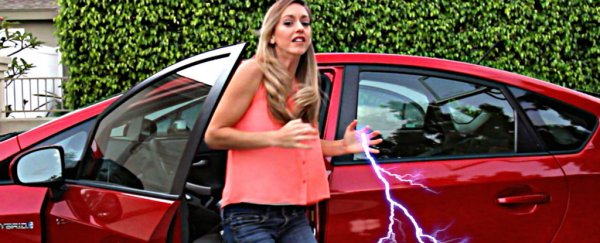If you're like me, it feels like every time you touch something metal, you get a shock. Cars in particular are a problem for those of us prone to static. But what exactly is causing these shocks, and what can you do to stop them happening? Physics Girl is here to break it down for you, and she's got the simplest trick so far for preventing electric shocks.
First of all, you need to understand how a shock works. Static charge builds up when an object's surface has lost a lot of electrons and builds up a positive charge.
Using a trusty Van de Graaff generator (which you may remember as that zappy sphere from high school science class), Physics Girl demonstrates how electrons will leap through the air from another object to try and restore the balance, creating a spark and a loud electric shock in the process.
And this is where things get fun. If you place a metal tray on top of the generator, it'll take on the same positive charge because it's conductive. And when the generator is turned on, the pan flies off like magic, because like charges repel like charges.
So then why does the same thing happens with a styrofoam bowl, which is an insulator? As Physics Girl explains, this is due to the same phenomenon that causes us to get electric shocks all the time.
To trigger that phenomenon, a violent event has to occur to strip electrons off one material and onto another, creating a positively and negatively charged surface. That sounds extreme, but that type of event could be something as simple as taking off your jumper, or sliding out of a car seat.
Over time, the excess electrons in the now-negatively charged object (AKA your body) will dissipate into the air. But when conditions are particularly cold and dry, or if you touch something else too soon, the electrons are going to fly off you, creating – you guessed it – a shock.
So how do you stop that happening? Physics Girl explains much better than us, so watch the video above to find out. But we'll give you a hint, it involves not allowing yourself to get isolated in the first place. Thank you, science.
